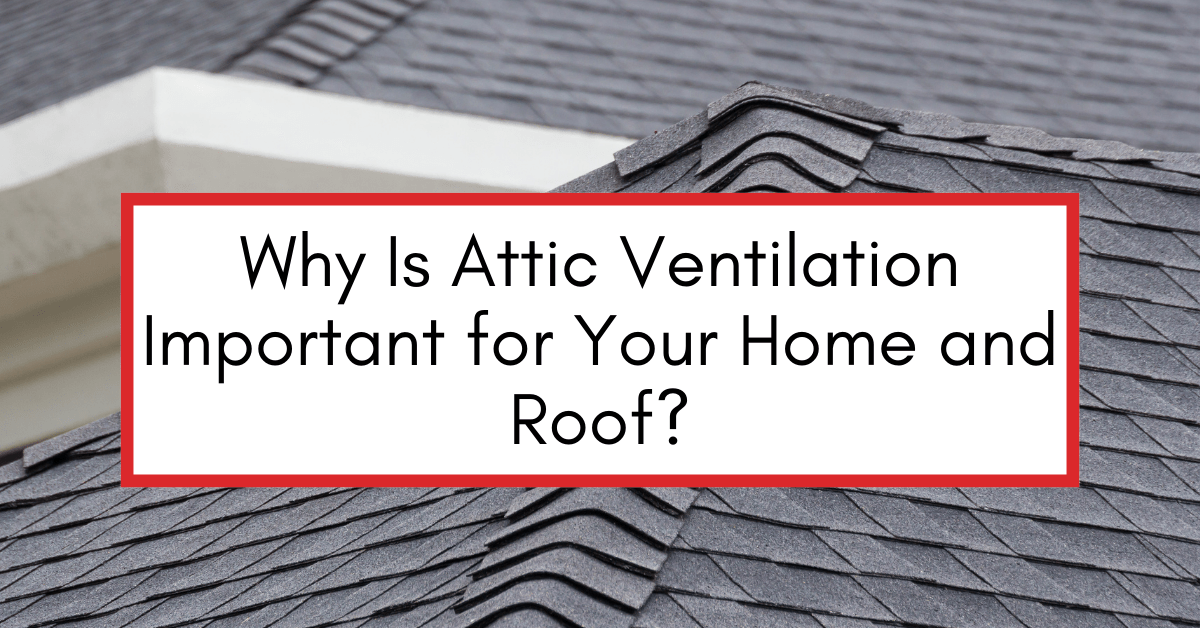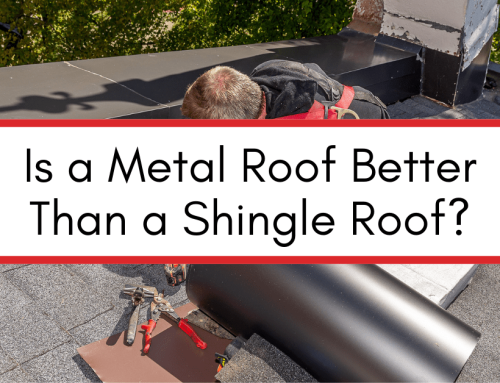Attic ventilation is often overlooked when it comes to maintaining the health and integrity of a home and its roof. However, it plays a crucial role in ensuring the overall well-being of your living space.
At AIC Roofing & Construction, we’ve helped homeowners navigate their roofing systems since 2003. In this article, we will explain the importance of attic ventilation, its impact on your roof, and how to know if your attic is properly ventilated.
Understanding the Concept of Attic Ventilation
Attic ventilation refers to the process of creating an airflow system within your attic space, allowing fresh air to enter while expelling hot, stagnant air. This airflow helps regulate temperature, remove excess moisture, and prevent the buildup of harmful substances such as mold and mildew.
Proper attic ventilation is crucial for maintaining the overall health and integrity of your home and for extending the longevity of your roof.
The Role of Attic Ventilation in a Home
An effective attic ventilation system serves multiple purposes that contribute to the overall health and comfort of your home:
- Air Quality. Attic ventilation helps maintain indoor air quality by preventing the accumulation of pollutants and excessive humidity. When your attic is properly ventilated, fresh air can circulate, reducing the risk of allergens, odors, and other airborne contaminants.
- Energy Efficiency. Attic ventilation plays a vital role in controlling the temperature and improving energy efficiency. During hot summer months, attics can become extremely hot, reaching temperatures that can damage the roof and increase cooling costs. By allowing hot air to escape and replacing it with cooler air, attic ventilation helps reduce the strain on your air conditioning system and keeps your home more comfortable.
- Prevent Mold and Mildew. Attic ventilation helps prevent moisture-related issues that can lead to costly repairs and health hazards. When warm, moist air from your home rises into the attic, it can condense on cooler surfaces, leading to the growth of mold and mildew. These harmful substances not only damage the structure of your home but can also cause respiratory problems and allergies. Proper ventilation allows moisture to escape, reducing the risk of mold and mildew growth.
Key Components of an Effective Attic Ventilation System
A well-designed attic ventilation system consists of various components working together to ensure proper airflow. These components include:
- Intake vents: Located at the eaves or soffits, which allow fresh air to enter the attic. Intake vents are typically designed to prevent the entry of rain, snow, and pests while still allowing air to flow freely.
- Exhaust vents: Situated at the roof’s peak or near the top, allowing hot air to escape from the attic. These vents are designed to prevent the entry of rain and snow while promoting the efficient expulsion of hot air.
- Attic fan: These can be installed to enhance airflow and improve ventilation in areas with limited natural airflow.
- Gable vents: Are typically located on the sides of the attic, can also contribute to proper ventilation by allowing air to enter and exit the attic space.
- Ridge vents: Are installed along the roof’s ridge, providing a continuous opening for hot air to escape.
It is important to consult with a professional to determine the specific ventilation needs of your attic. Factors such as the size of your attic, climate conditions, and the type of roofing material used can all affect the design and installation of an effective attic ventilation system.
The Importance of Attic Ventilation for Your Home
Now that we understand the concept of attic ventilation, let’s delve into why it is crucial for your home.
Attic ventilation plays a significant role in maintaining the overall health and well-being of your home. It goes beyond just providing a way for hot air to escape; it has a direct impact on indoor air quality, temperature control, energy efficiency, and preventing moisture-related issues.
Maintaining Indoor Air Quality
Poorly ventilated attics can become breeding grounds for pollutants, such as dust, allergens, and volatile organic compounds (VOCs). These harmful substances can seep into your living spaces, leading to respiratory issues and allergies. Proper attic ventilation ensures that the indoor air quality remains fresh and free from contaminants.
Imagine taking a deep breath in your home and feeling the crispness of clean air filling your lungs. With adequate attic ventilation, you can enjoy just that. The constant flow of fresh air helps remove any stagnant or polluted air, creating a healthier living environment for you and your family.
Controlling Temperature and Energy Efficiency
Attics can become stiflingly hot during the summer months, especially in regions with high temperatures. Without proper ventilation, this trapped heat can transfer into your living spaces, forcing your cooling systems to work harder and consume more energy. By allowing hot air to escape and fresh air to replace it, attic ventilation helps regulate the temperature, resulting in significant energy savings.
Not only does attic ventilation help keep your home comfortable, but it also contributes to energy efficiency. When your cooling systems don’t have to work as hard to combat the heat buildup, you’ll notice a decrease in your energy bills. It’s a win-win situation for both your wallet and the environment.
Preventing Moisture and Mold Growth
Moisture is a common issue in attics, and when left unchecked, it can lead to mold and mildew growth. These toxic substances not only pose health risks but can also damage the structural integrity of your home. Attic ventilation helps remove excess moisture, reducing the likelihood of mold formation and safeguarding your home’s overall health.
Imagine the peace of mind knowing that your attic is free from moisture-related problems. With proper ventilation, you can bid farewell to the musty smell and unsightly mold patches that can plague poorly ventilated attics. Your home will be protected from potential structural damage, ensuring its longevity and value.
The Impact of Attic Ventilation on Your Roof
Beyond the benefits it provides for your home, proper attic ventilation also plays a significant role in maintaining the health and lifespan of your roof.
When it comes to the longevity of your roof, the impact of attic ventilation cannot be overstated. The hot and humid conditions that often plague the summer months can wreak havoc on your roof if not properly managed. Without adequate ventilation, the excessive heat trapped in your attic can cause your shingles to deteriorate and age prematurely. This can lead to costly repairs or even the need for a full roof replacement.
However, with the help of attic ventilation, you can keep your roof cool and extend its lifespan. By allowing the trapped heat to escape, ventilation helps to regulate the temperature in your attic. This not only prevents your shingles from deteriorating but also reduces the risk of other potential issues that can arise from excessive heat.
Extending the Lifespan of Your Roof
Hot, humid conditions can take a toll on your roof, particularly during the summer months. The excessive heat trapped in an attic without ventilation can cause shingles to deteriorate and age prematurely. By allowing heat to escape, attic ventilation helps to cool the roof, extending its lifespan and reducing the need for costly repairs or replacements.
Furthermore, proper attic ventilation can also help to prevent ice dams from forming on your roof during the winter months. Ice dams occur when snow on the roof melts and refreezes at the eaves, causing water to back up and potentially seep into your home. With adequate ventilation, the temperature in your attic remains consistent, preventing the snow from melting unevenly and reducing the likelihood of ice dams.
Preventing Roof Damage and Decay
Moisture is one of the primary enemies of a roof. Without proper ventilation, condensation can accumulate in the attic, leading to the growth of mold, mildew, and wood rot. These issues weaken the roof structure, compromising its integrity, and making it more susceptible to leaks and further damage. Attic ventilation helps combat moisture buildup, safeguarding your roof from decay and prolonging its longevity.
In addition to preventing moisture-related issues, proper attic ventilation can also help to improve the air quality in your home. Without ventilation, the stagnant air in your attic can become a breeding ground for pollutants and allergens. By allowing fresh air to circulate, ventilation helps to remove these harmful substances, creating a healthier living environment for you and your family.
Enhancing Roof Performance During Extreme Weather Conditions
During extreme weather events, such as storms or high winds, the roof is exposed to significant stress. A well-ventilated attic helps equalize the air pressure inside and outside the home, reducing the risk of wind damage or uplift. Additionally, effective ventilation helps prevent the buildup of excess heat or moisture that can exacerbate the impact of severe weather conditions on your roof.
Moreover, attic ventilation can also contribute to energy efficiency in your home. By allowing hot air to escape during the summer, ventilation helps to reduce the strain on your air conditioning system, leading to lower energy bills. In the winter, proper ventilation prevents the buildup of moisture, which can lead to insulation damage and higher heating costs.
In conclusion, attic ventilation is not only crucial for maintaining a comfortable and energy-efficient home but also plays a vital role in preserving the health and longevity of your roof. By preventing premature aging, protecting against moisture-related issues, and enhancing roof performance during extreme weather conditions, proper attic ventilation is an investment that pays off in the long run.
Is Your Attic Properly Ventilated?
Is your attic properly ventilated? If you suspect your attic may have issues with ventilation, it’s best to get your roof inspected. Inspections are free, and your attic as well as your attic ventilation will be thoroughly inspected.
AIC Roofing & Construction has replaced over 10,000 roofs in the Cincinnati, Lexington, Louisville and Richmond, KY areas. We are in the top 2% of roofing contractors in North America that received the GAF Master Elite Certification. Working with a GAF Master Elite certified contractor should give you peace of mind that you’re working with an experienced roofer that has undergone rigorous training. Along with our GAF Master Elite certification is an extended material and craftsmanship warranty. We renew this certification every year as part of our commitment to excellence. If you’re preparing for a roof replacement or would like a second opinion – only trust your home to the best. Contact us today for your free roof inspection.
3-tab attics barns chimney choosing a contractor commercial cost curb appeal DIY estimate financing flashing flat roof GAF glossary gutter replacement gutters gutter size gutter system ice dams inspections insurance missing shingles roof design roofing materials roofing system roof leak roof maintenance roof materials roof repair roof replacement roof shapes roof types shingle ratings shingles siding siding materials siding replacement skylights storm damage underlayment ventilation warranty winter







